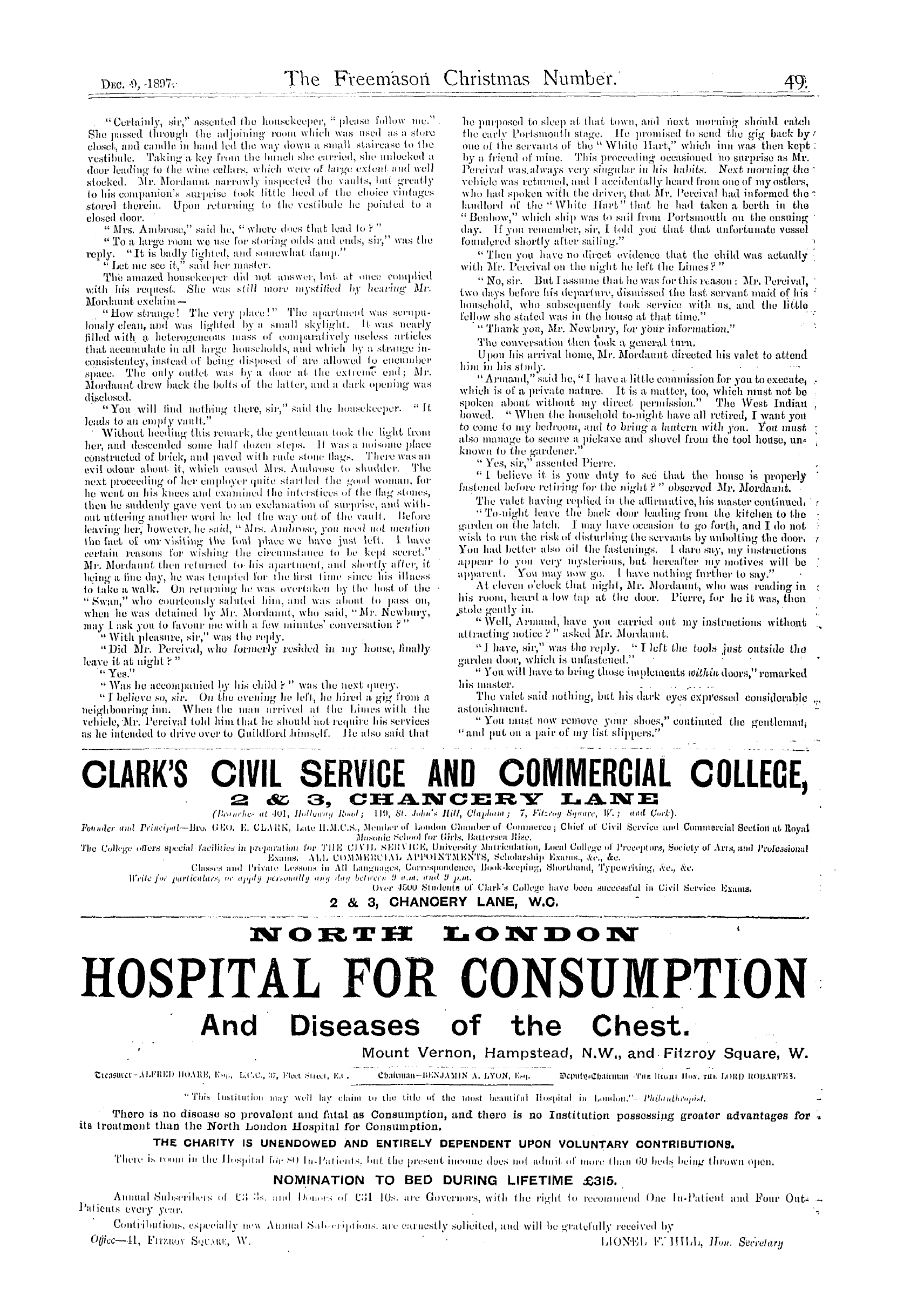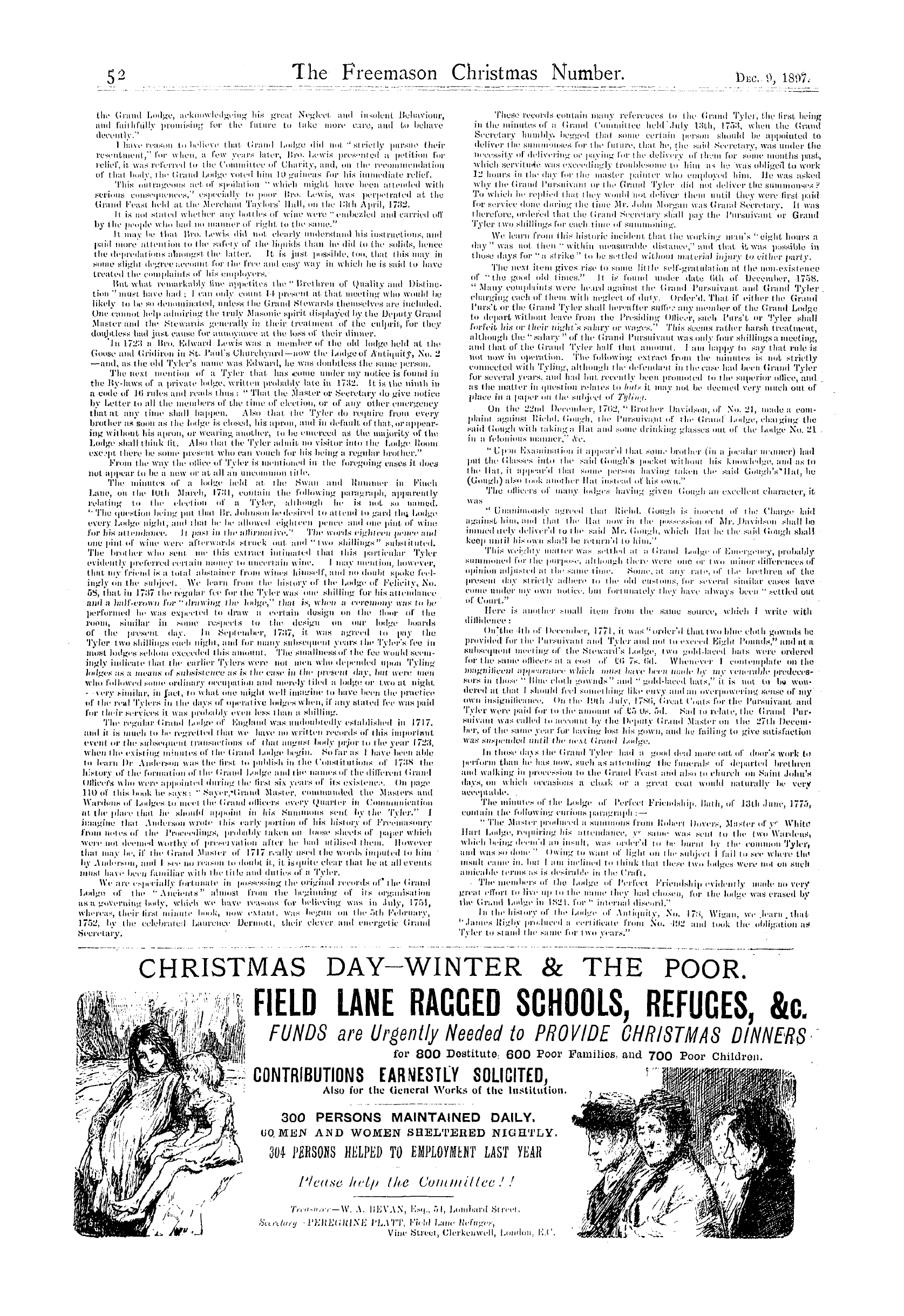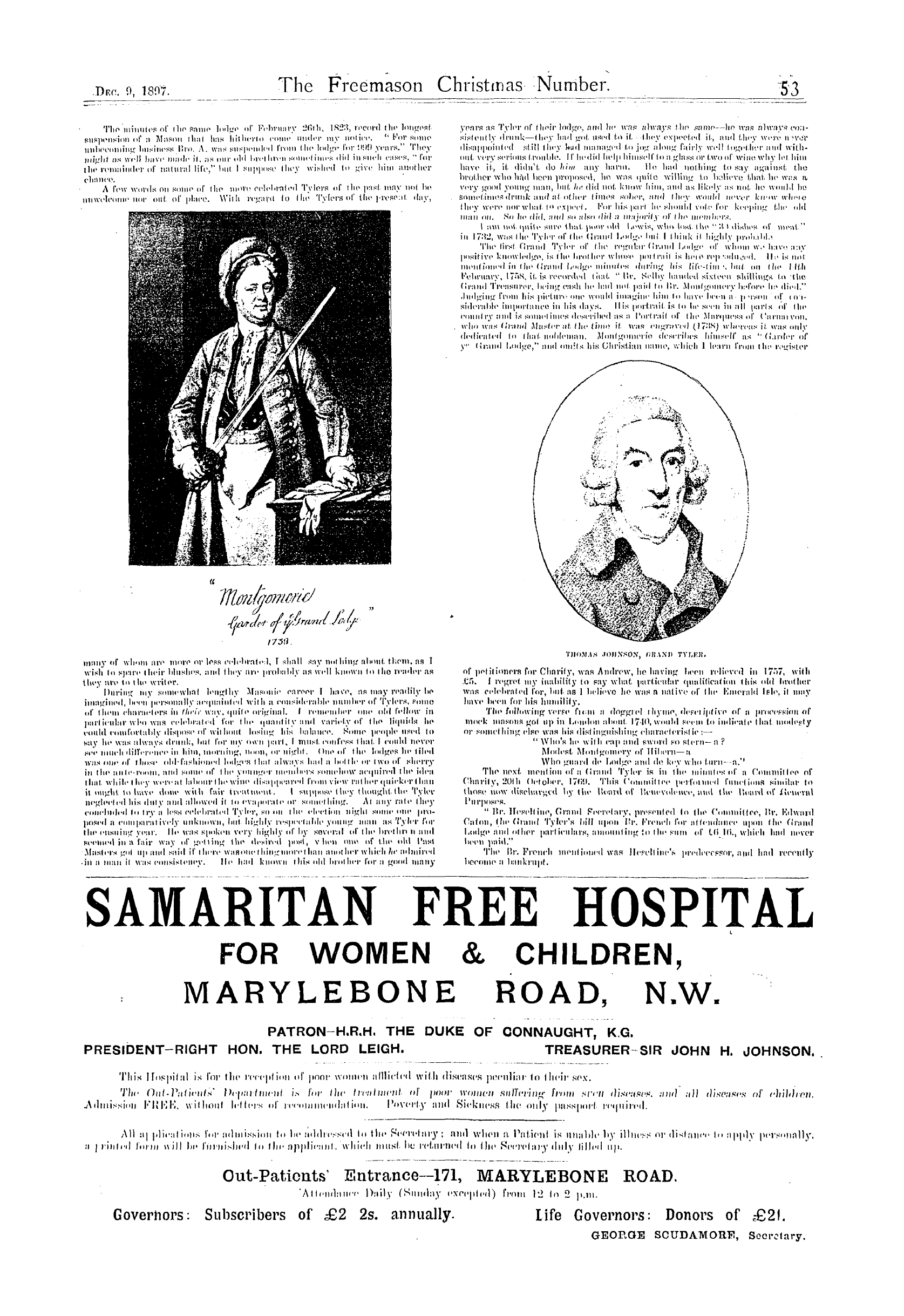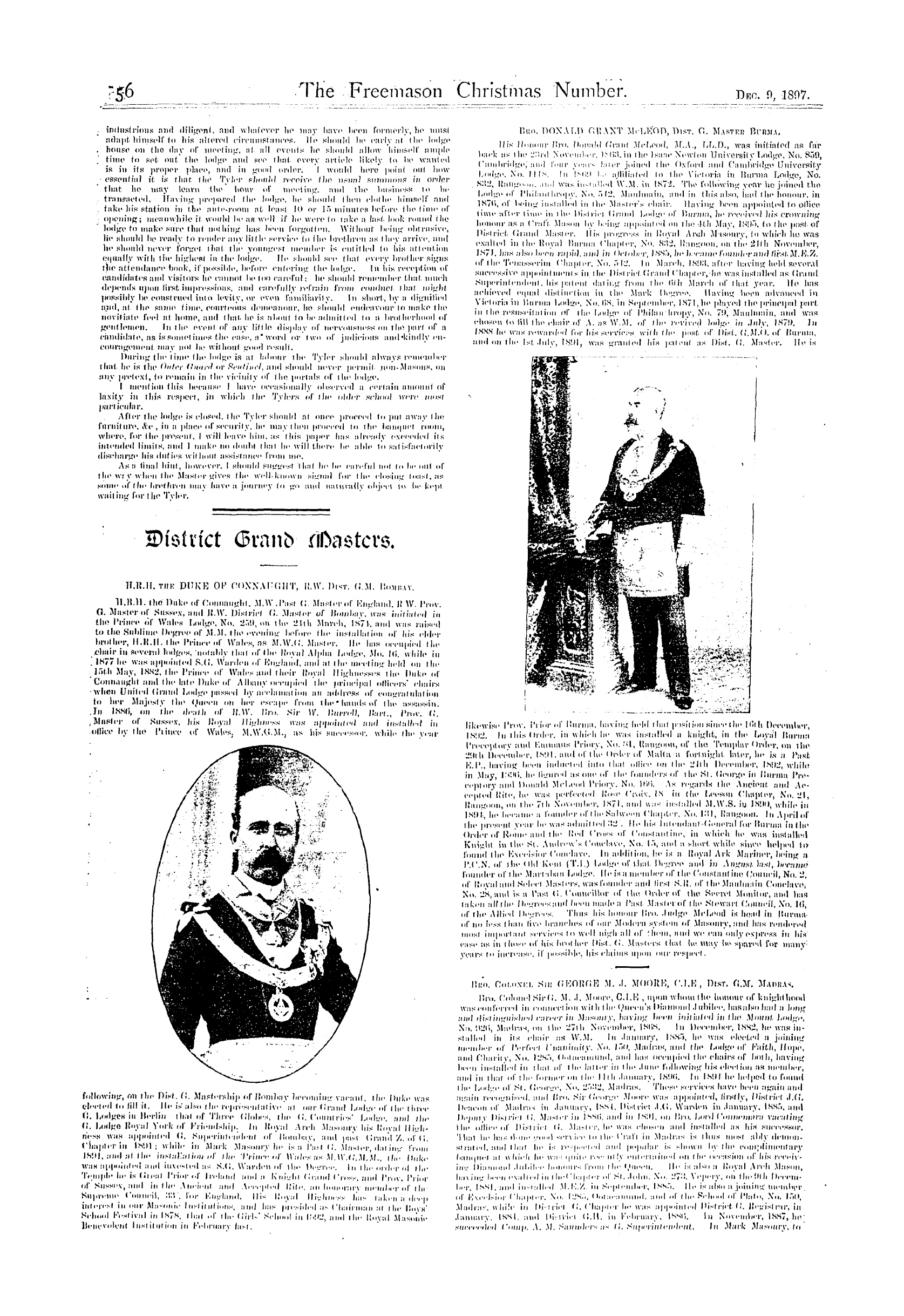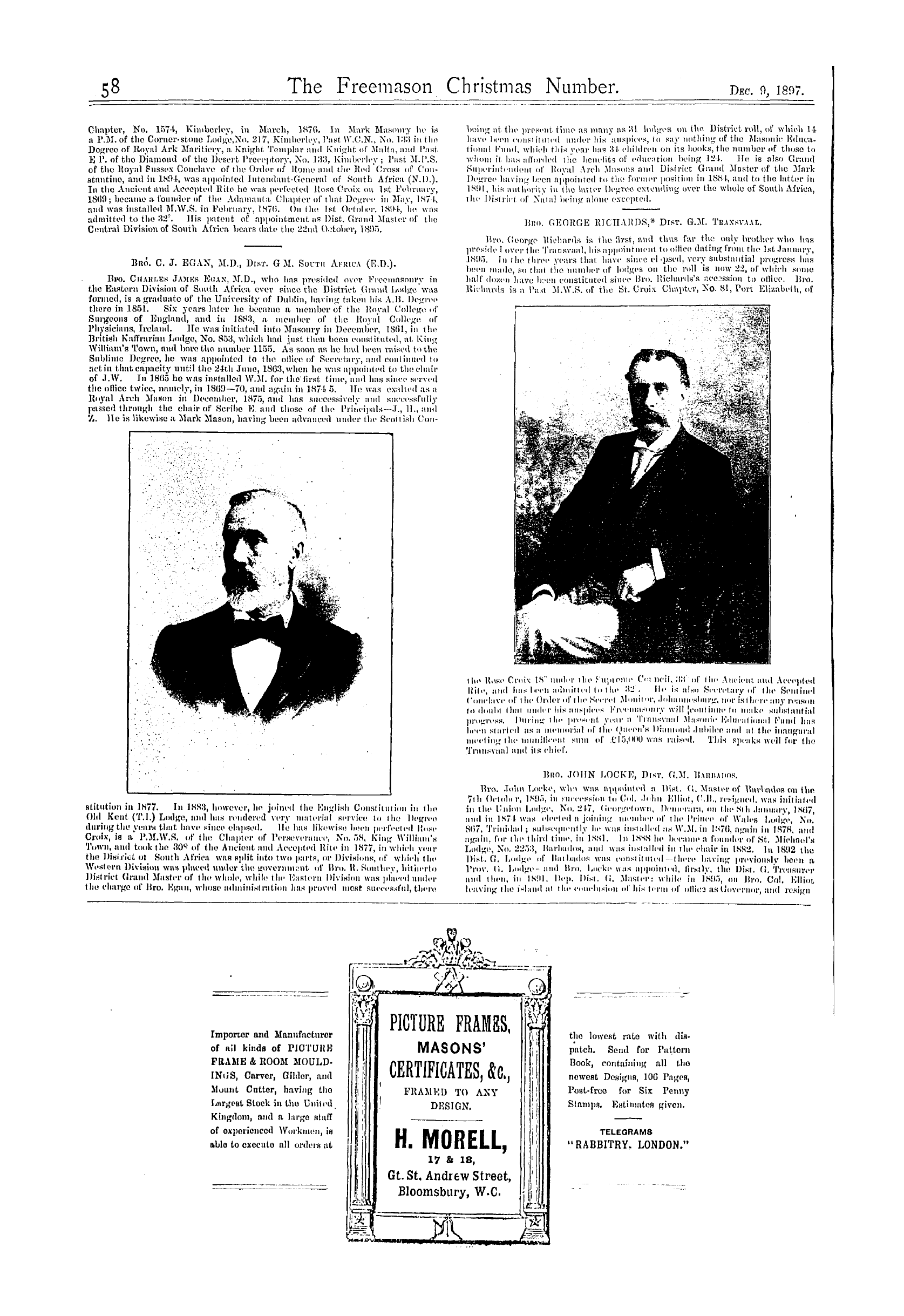-
Articles/Ads
Article Quatuor Coronati Lodge, No. 2076. ← Page 3 of 5 →
Note: This text has been automatically extracted via Optical Character Recognition (OCR) software.
Quatuor Coronati Lodge, No. 2076.
moons in attendance , but they have scarcely anv light to reflect . The sun is only a star now ; but wc must hasten on deeper and deeper into space . We shall again , as formerly , have to go as far beyond the last planet as that planet is from the sun . The mind cannot grasp these huge distances . Still we
travel on to the last planet , Neptune , revolving on its lonely orbit , sunk so deep into space that though it rushes round thc sun at tbe rate of 22 , 000 miles an hour , it takes 16 4 of our years to complete one revolution . Now let us look back from this remote point . What do wc see ? One planet only , Uranus , is
visible to the unaided eye ; the giant planets , Jupiter and Saturn , have disappeared , and ihe sun itself is no larger than a small star ; no heat , no light ; all is darkness in this solitary world . Thus far have we gone , and standing there at the enormous distance of 3 , , 000 , 000 miles from our starting point , wc can begin
to comprehend thc vast limits of thc solar system ; we can begin to understand the ways of this mighty family of planets and satellites . But let us not set up too small a standard whereby lo measure tbe Infinity of Space . We shall find , as we go on , that this stupendous system is but au infinitesimal part of the whole
universe . Let us now look forward along thc path wc are to lake . We are standing on the outermost part of our solar system , and there is no other planet towards which we can wing our flight ; but all around there are multitudes of stars , some shining with a
briiditness almost equal to what our sun appears to give forth at that great distance , others hardly visible , but the smallest telescope increases their number enormousl y , and presents to our mind the appalling phantom of immensit y in all its terror standing there to withstand our next great step . How are wc to continue on
our journey when our very senses sccin paralysed bv this obstruction and even imagination is powerless from utter loneliness ? One guide onl y is there lo help us , the guide so prized by every Mason , the messenger which Hits from star lo slar , universe to universe ; LIGHT il is which will help us to
appreciate even these vast distances ; we shall take its velocity as our foot rule to measure and sound these bottomless depths . Now , light travels 186 , 000 miles per second , or 12 , 000 , 000 miles every minute of time . It , therefore , takes only about four hours to traverse the huge distance between our sun and Neptune , where
wc are now supposed to be standing . But to leap across the interval which separates us from thc nearest fixed star will require a period not to be reckoned by hours or by dais or by months : —Nearly ten long years must roll away ' before light , travelling with its enormous velocity , can complete its journey .
Now let us use this to continue our voyage . On a clear ni ght the human eye can perceive thousands of stars in all directions , scattered without any apparent order or design -, but in one locality , forming a huge ring round the heavens , there is a misty zone called the Milky Way . Let us turn a telescope with a low
aperture on this , and what a si ght presents itself . Instead of mist , myriads of stars arc seen surrounded by nebulous haze . We put a higher aperture on , and thus pierce further and further into space ; the haze is resolved into myriads more stars , and more haze comes up from the deep bevond , showing that the
visual ray was not yet strong enough to fathom the mighty distance , but let the full aperture be applied and mark the result . Mist and haze have disappeared ; the telescope has pierced right through the stupendous distances , and only the vast abyss of space , boundless and unfathomable , is seen beyond . Let us
pause here for a moment to think what wc have done Light , travelling with its enormous velocity , requires as a minimum average , ten years to traverse the distance between our solar system and stars of the lirst magnitude ; but the dimensions of the Milky Way arc built up on such an enormous scale lhat lo
traverse the stratum would require us lo pass about 500 stars , separated from each other by this same tremendous interval ; 10 , 000 years may therefore be computed as the time which light , travelling with its enormous velocity , would take to sweep across
the whole cluster , it being borne in mind ( hat ( he solar system is supposed to be located not far from llie centre of this ' grcat slar cluster , that the cluster comprises all stars visible arrayed in a Hat zone , the edges of which , where the stratum is deepest , being the locality of the Milky Way .-
Let us once more continue our journey . Wc have traversed a distance which even on the wings of light we could only accomplish in io , nco years , and now stand on the outskirts ' of a great star cluster , in the same way , and , 1 hope , with the :-ame aspirations , as when we paused a short time ago on ihe confines
of our solar system . Behind us are myriads nf shining orbs , in such countless numbers that human thought cannot even suogesl a limit , and yet each of these is a might v globe like our sun , ihe
centre of a planetary system , dispensing light and heat under conditions similar lo whal we arc acciislomed io here . Let us however , turn our lace away from these clusterings of mighty suns , and look steadfastl y forward into the unbroken darkness
and once more brace our nerves to face that terrible phantom—Immensity . We require now thc most jjowerftil instruments that science can put into our hands ; and by their aid we will again essay to make another stride towards the appreciation of our subject . In whal lo the unaided eye was unbroken
darkness , thc telescope now enables us to discern a number of luminous j ) oints of haze , and towards one of these wc continue our journey . The myriads of suns in our great star cluster arc soon being left far behind . They shrink together , resolve themselves into haze , until the once glorious universe of countless
millions of suns have dwindled down to a mere point of haze almost invisible to thc naked eye . But look forward . 'I'he luminous cloud to which wc were urging our ( li ght has expanded , until what al one time was a mere patch of light , has now swelled into a mightv slar cluster ; myriads of suns burst into sight—wc
have reached the confines of another Milky Way as glorious and mighty as the one we have left , whose limits light would require 10 , 000 years to traverse ; and yet in whatever direction the tele scope is placed , slar clusters are to be seen strewn over the whole surface of the heavens . Lotus take nowtheutmost limit of the
telescopic power in every direction . Where are we after all but in thc centre of a sphere whose circumference is 65 , 000 limes as far from us as the nearest fixed star , and beyond whose circuit infinity , boundless infinity , still stretches unfathomed as ever ; we have made a step indeed , but , perhaps , only towards acquaintance
with a new order of infinitesimals ; once the distances of our solar system seemed almost inlinile quantities ; compare them with the intervals between the fixed stars , and thev become no quantities at all . And now when thc spaces between the stars arc contrasted wilh the gulfs of dark space separating
firmaments , they absolutely vanish below us . Can the whole lirmamcntal creation in its turn be only a corner of some mi ghlici scheme ? But let us not go on to bewilderment—we have passed from planet to planet , star to star , universe to universe , and still inlinile space extends for ever beyond our grasp . We have
gone as far towards the infinite as our sight , aided bv the most powerful telescopes , can hope to go . Is there nu way then b y which wc can continue our journey further towards the appreciation of this infinity V A few years ago we should probably
have denied that it was possible for man to go further ; but quite lately a new method of observation has been developed . This I shall take for my next stejiping stone , under the heading of Celestial Photography .
We will , as in the former lnslan . e , commence at the very bottom of the ladder aud consider this question . Whv is it that the further an object is withdrawn from the eye thc jainltr and smaller lhat object becomes , until at last il disapjicars altogether from sight ? There are two quite distinct reasons lor this .
First , thc rays from any shining j-oinl diverge from such point in all directions ; hence the nearer the object the greater thc number of rays which will enter the pupil of the eye ; and , conversely , when the object is removed to a great distance , so small a quantity of light finds its way into the eye that it fails to excite
( he retina sufficiently to cause the impression of sight , and ( he object is invisible . Now , if you lake a lens , or what is popularly called a burning-glass , and place it in the beams of the sun , you will see that it gathers all tbe rays falling on ils surface into a bright point of light behind il ; now place such a lens between
your eye and a star , taking a star so far away lhat the eye unaided can only just see it as a glimmer of light , what happens ? Why , instead of the eye receiving only a faint and almost imperceptible quantity of light , it appears now to lake in the whole mass of rays which pass through the larger lens , for the
lens has caused them lo converge into a pencil of li ght sufficientl y minute to enter tbe eye ; thus the eve receives as much li ght as though the pupil had been enlarged lo the dimensions of the lens . Thus armed , to what remoteness may we not now reach . The star might now be withdrawn so deep into space that the whole
lig ht concentrated by the lens is not more intense than the faint ray was from the star in its first position ; and this mighty acquisition has been attained b y the simple interposition of a piece of glass , and of course the larger the lens the further we can pierce into sjiacc . Wc now come back to the second part
of our question : " Why docs an object become apparently smaller and smaller as it is withdrawn , from the eye , until it at last disappears from sight ? " The reason is , lhat the eve is a very imperfect instrument for viewing objects at a great distance ; the eye can only see an object when it is near enough to subtend
a certain angle , or , 111 popular language , to shew itself a certain size—in fact , the eye cannot single nut and ajijireciate parallel rays . Could it do this , objects would nul jvrow smaller as they ire removed . This pencil might be removed to the niuoii ,
240 , 000 miles away , and would still appear to the eye the same size as it does here close lo you , hid the result would he . inconvenient . You would never be able lo see at one and thc same time anything larger than the pupil of your eye . The beauties
Note: This text has been automatically extracted via Optical Character Recognition (OCR) software.
Quatuor Coronati Lodge, No. 2076.
moons in attendance , but they have scarcely anv light to reflect . The sun is only a star now ; but wc must hasten on deeper and deeper into space . We shall again , as formerly , have to go as far beyond the last planet as that planet is from the sun . The mind cannot grasp these huge distances . Still we
travel on to the last planet , Neptune , revolving on its lonely orbit , sunk so deep into space that though it rushes round thc sun at tbe rate of 22 , 000 miles an hour , it takes 16 4 of our years to complete one revolution . Now let us look back from this remote point . What do wc see ? One planet only , Uranus , is
visible to the unaided eye ; the giant planets , Jupiter and Saturn , have disappeared , and ihe sun itself is no larger than a small star ; no heat , no light ; all is darkness in this solitary world . Thus far have we gone , and standing there at the enormous distance of 3 , , 000 , 000 miles from our starting point , wc can begin
to comprehend thc vast limits of thc solar system ; we can begin to understand the ways of this mighty family of planets and satellites . But let us not set up too small a standard whereby lo measure tbe Infinity of Space . We shall find , as we go on , that this stupendous system is but au infinitesimal part of the whole
universe . Let us now look forward along thc path wc are to lake . We are standing on the outermost part of our solar system , and there is no other planet towards which we can wing our flight ; but all around there are multitudes of stars , some shining with a
briiditness almost equal to what our sun appears to give forth at that great distance , others hardly visible , but the smallest telescope increases their number enormousl y , and presents to our mind the appalling phantom of immensit y in all its terror standing there to withstand our next great step . How are wc to continue on
our journey when our very senses sccin paralysed bv this obstruction and even imagination is powerless from utter loneliness ? One guide onl y is there lo help us , the guide so prized by every Mason , the messenger which Hits from star lo slar , universe to universe ; LIGHT il is which will help us to
appreciate even these vast distances ; we shall take its velocity as our foot rule to measure and sound these bottomless depths . Now , light travels 186 , 000 miles per second , or 12 , 000 , 000 miles every minute of time . It , therefore , takes only about four hours to traverse the huge distance between our sun and Neptune , where
wc are now supposed to be standing . But to leap across the interval which separates us from thc nearest fixed star will require a period not to be reckoned by hours or by dais or by months : —Nearly ten long years must roll away ' before light , travelling with its enormous velocity , can complete its journey .
Now let us use this to continue our voyage . On a clear ni ght the human eye can perceive thousands of stars in all directions , scattered without any apparent order or design -, but in one locality , forming a huge ring round the heavens , there is a misty zone called the Milky Way . Let us turn a telescope with a low
aperture on this , and what a si ght presents itself . Instead of mist , myriads of stars arc seen surrounded by nebulous haze . We put a higher aperture on , and thus pierce further and further into space ; the haze is resolved into myriads more stars , and more haze comes up from the deep bevond , showing that the
visual ray was not yet strong enough to fathom the mighty distance , but let the full aperture be applied and mark the result . Mist and haze have disappeared ; the telescope has pierced right through the stupendous distances , and only the vast abyss of space , boundless and unfathomable , is seen beyond . Let us
pause here for a moment to think what wc have done Light , travelling with its enormous velocity , requires as a minimum average , ten years to traverse the distance between our solar system and stars of the lirst magnitude ; but the dimensions of the Milky Way arc built up on such an enormous scale lhat lo
traverse the stratum would require us lo pass about 500 stars , separated from each other by this same tremendous interval ; 10 , 000 years may therefore be computed as the time which light , travelling with its enormous velocity , would take to sweep across
the whole cluster , it being borne in mind ( hat ( he solar system is supposed to be located not far from llie centre of this ' grcat slar cluster , that the cluster comprises all stars visible arrayed in a Hat zone , the edges of which , where the stratum is deepest , being the locality of the Milky Way .-
Let us once more continue our journey . Wc have traversed a distance which even on the wings of light we could only accomplish in io , nco years , and now stand on the outskirts ' of a great star cluster , in the same way , and , 1 hope , with the :-ame aspirations , as when we paused a short time ago on ihe confines
of our solar system . Behind us are myriads nf shining orbs , in such countless numbers that human thought cannot even suogesl a limit , and yet each of these is a might v globe like our sun , ihe
centre of a planetary system , dispensing light and heat under conditions similar lo whal we arc acciislomed io here . Let us however , turn our lace away from these clusterings of mighty suns , and look steadfastl y forward into the unbroken darkness
and once more brace our nerves to face that terrible phantom—Immensity . We require now thc most jjowerftil instruments that science can put into our hands ; and by their aid we will again essay to make another stride towards the appreciation of our subject . In whal lo the unaided eye was unbroken
darkness , thc telescope now enables us to discern a number of luminous j ) oints of haze , and towards one of these wc continue our journey . The myriads of suns in our great star cluster arc soon being left far behind . They shrink together , resolve themselves into haze , until the once glorious universe of countless
millions of suns have dwindled down to a mere point of haze almost invisible to thc naked eye . But look forward . 'I'he luminous cloud to which wc were urging our ( li ght has expanded , until what al one time was a mere patch of light , has now swelled into a mightv slar cluster ; myriads of suns burst into sight—wc
have reached the confines of another Milky Way as glorious and mighty as the one we have left , whose limits light would require 10 , 000 years to traverse ; and yet in whatever direction the tele scope is placed , slar clusters are to be seen strewn over the whole surface of the heavens . Lotus take nowtheutmost limit of the
telescopic power in every direction . Where are we after all but in thc centre of a sphere whose circumference is 65 , 000 limes as far from us as the nearest fixed star , and beyond whose circuit infinity , boundless infinity , still stretches unfathomed as ever ; we have made a step indeed , but , perhaps , only towards acquaintance
with a new order of infinitesimals ; once the distances of our solar system seemed almost inlinile quantities ; compare them with the intervals between the fixed stars , and thev become no quantities at all . And now when thc spaces between the stars arc contrasted wilh the gulfs of dark space separating
firmaments , they absolutely vanish below us . Can the whole lirmamcntal creation in its turn be only a corner of some mi ghlici scheme ? But let us not go on to bewilderment—we have passed from planet to planet , star to star , universe to universe , and still inlinile space extends for ever beyond our grasp . We have
gone as far towards the infinite as our sight , aided bv the most powerful telescopes , can hope to go . Is there nu way then b y which wc can continue our journey further towards the appreciation of this infinity V A few years ago we should probably
have denied that it was possible for man to go further ; but quite lately a new method of observation has been developed . This I shall take for my next stejiping stone , under the heading of Celestial Photography .
We will , as in the former lnslan . e , commence at the very bottom of the ladder aud consider this question . Whv is it that the further an object is withdrawn from the eye thc jainltr and smaller lhat object becomes , until at last il disapjicars altogether from sight ? There are two quite distinct reasons lor this .
First , thc rays from any shining j-oinl diverge from such point in all directions ; hence the nearer the object the greater thc number of rays which will enter the pupil of the eye ; and , conversely , when the object is removed to a great distance , so small a quantity of light finds its way into the eye that it fails to excite
( he retina sufficiently to cause the impression of sight , and ( he object is invisible . Now , if you lake a lens , or what is popularly called a burning-glass , and place it in the beams of the sun , you will see that it gathers all tbe rays falling on ils surface into a bright point of light behind il ; now place such a lens between
your eye and a star , taking a star so far away lhat the eye unaided can only just see it as a glimmer of light , what happens ? Why , instead of the eye receiving only a faint and almost imperceptible quantity of light , it appears now to lake in the whole mass of rays which pass through the larger lens , for the
lens has caused them lo converge into a pencil of li ght sufficientl y minute to enter tbe eye ; thus the eve receives as much li ght as though the pupil had been enlarged lo the dimensions of the lens . Thus armed , to what remoteness may we not now reach . The star might now be withdrawn so deep into space that the whole
lig ht concentrated by the lens is not more intense than the faint ray was from the star in its first position ; and this mighty acquisition has been attained b y the simple interposition of a piece of glass , and of course the larger the lens the further we can pierce into sjiacc . Wc now come back to the second part
of our question : " Why docs an object become apparently smaller and smaller as it is withdrawn , from the eye , until it at last disappears from sight ? " The reason is , lhat the eve is a very imperfect instrument for viewing objects at a great distance ; the eye can only see an object when it is near enough to subtend
a certain angle , or , 111 popular language , to shew itself a certain size—in fact , the eye cannot single nut and ajijireciate parallel rays . Could it do this , objects would nul jvrow smaller as they ire removed . This pencil might be removed to the niuoii ,
240 , 000 miles away , and would still appear to the eye the same size as it does here close lo you , hid the result would he . inconvenient . You would never be able lo see at one and thc same time anything larger than the pupil of your eye . The beauties















































